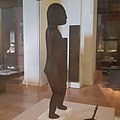| Mangareva Statue | |
|---|---|
 Detail of the Mangareva Statue in the British Museum | |
| Material | Wood |
| Size | 115 cm high |
| Created | Late eighteenth or early nineteenth century AD |
| Present location | British Museum, London |
| Registration | AOA LMS 99 |
The Mangareva Statue or Deity Figure from Mangareva is a wooden sculpture of a male god that was made on the Pacific island of Mangareva in French Polynesia. The cult image was given to English missionaries in the early nineteenth century as the local population converted to Christianity. It was eventually bought by the British Museum in 1911. [1]

